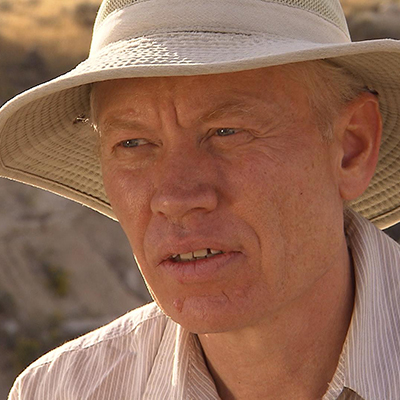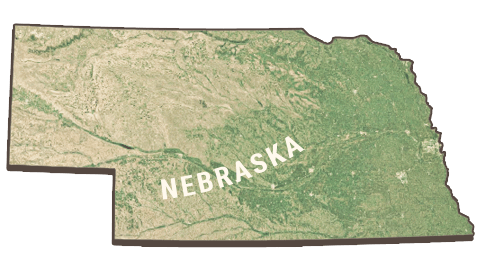
Ross Secord uses modern technology to study Nebraska’s prehistoric life and ancient climates. Like fellow University of Nebraska paleo sleuth Mike Voorhies, he appreciates the importance of a fossil’s place in layers of rock—and layers of time.
The classic image of a detective is a sharp-eyed person peering at clues through a magnifying glass. Paleo sleuth Ross Secord looks even closer, examining stable isotopes to study the ancient habitats of mammals and how they responded to climate change.
Stable isotope analysis of tooth enamel also provides an estimate of the relative temperature when that particular animal changes through time.
One of Secord’s main areas of study has been the Paleocene-Eocene Thermal Maximum (PETM), a short period of extremely high global temperatures that briefly spiked about 56 MYA.
“Stable isotopes of oxygen and carbon from mammal teeth are providing clues to climate and ecological change that occurred in the PETM,” Secord noted, “I am interested in applying similar methods to other intervals of marked climate change to learn more about the response of mammalian communities to climate and ecological change.”
He is currently working with collaborators from other institutions to develop high-resolution records of climate and faunal change through hyperthermal events in Wyoming and New Mexico. Secord has also mentored graduate students that have used stable isotopes in fossil teeth from Nebraska to study paleo-habitats in the Miocene Epoch, and to investigate climate change across the Eocene-Oligocene boundary (34 MYA) in Toadstool Geologic Park.
Secord also studies mammalian biostratigraphy for the purpose of dating faunas and for correlating them to the global geologic time scale.

Monographic work on late Paleocene mammals from the Bighorn Basin, Wyoming [published Secord, 2008, Papers on Paleontology, freely available online]; lead author on group papers in the world’s top scientific journals, Nature and Science, about climate and mammalian change during the PETM [Nature, 2010; Science, 2012]; has named 19 new mammal species.
Ross Secord has stated, “My current research focuses on a series of Paleogene mammalian dispersal events, the largest of which occurred during the Paleocene-Eocene thermal maximum (PETM).” Warm temperatures during the PETM allowed mammals to cross high latitude land bridges and enter North America from other continents. Some of the mammals that first appear in North America during the PETM are primates and ungulates-- hoofed mammals, including odd-toed mammals such as horses, rhinos, and tapirs, as well as the even-hoofed mammals such camels, cattle, deer, and antelope.
Perissodactyla and Artiodactyla are modern ungulates, Secord explained. Along with the earliest known primates of modern aspect, these mammals first appear in North America, Europe, and Asia during the PETM.
Evidence of this warming during hyperthermals can also be found in other creatures living in the seas and on the continents at the same time.
“The arrival of these immigrants dramatically and permanently altered the composition of faunas,” he said. The addition of these new taxa was an important step toward the modern faunas we have today.
Use this 3D model to explore an Oredont fossil like the one Secord mentions in the video:
Carrie Herbel is chief preparator for the University of Nebraska State Museum's vertebrate paleontology collection. She leads a team that must document and preserve over a million fossils that make up the museum's collections. She told an interviewer, “I love it because you never know what you are going to find or discover when you work on a fossil.” Herbel's work includes making molds and casts of fossils in the museum's collections. Some are used to create replicas for exhibit, but most casts are made for research purposes and loaned to other institutions and paleontologists. This lessens the risk of one-of-a-kind specimens being lost or damaged. Replicas also help provide aids for teaching and outreach. Herbel also works with fossils that come in from excavations and must be carefully removed from field jackets and preserved as part of the museum's collections. The preparators are dealing with some fossils that were collected back in the 1930s and early 1940s, along with more recent collections. They assist university researchers such as Ross Secord. They handle fossils ranging in size from microfossils (fossils so small they must be studied under a microscope) to mammoth skulls.
Watch to find out how a modern paleo sleuth safely removes and transports specimens from the field.
Along with stable isotopes, a paleo sleuth can use several types of evidence to figure out the age of a specimen to help establish the sequence of events in the timeline of life. Depending on where your fossil was found and how old it is, some methods will tell you more than others.
Dendrochronology-This involves measuring the thickness of rings formed each year by trees in response to climate shifts. This method is seldom used in Nebraska because wood is usually not well-preserved here.
Radiocarbon-This involves measuring the degree of radioactivity in organic material (for example, wood, seeds, bones, or shells). Living things build up carbon 14, but when they die, carbon 14 decays at a steady rate. The amount of carbon 14 left in the remains of a plant or animal can indicate when it died. Specimens up to 50,000 years old can be dated this way.
Biostratigraphy-This involves looking at where a fossil was found and determining its position within a sequence of sediment layers to help determine the relative age of the fossil.
Argon-40/Argon-39 Dating-This uses laboratory measurements of the amount of the radioactive isotope argon-40 and argon gas (the resulting stable isotope) found in minerals that occur in volcanic rocks to determine when the crystals formed. Specimens as recent as 500,000 years old on up to moon rocks more than 4 billion years old have been dated this way.
Fission tracks-Fission tracks are microscopic damage spots caused by the decay of small amounts of uranium trapped in volcanic materials. There are no fission tracks in minerals that have just erupted from a volcano, but over time, fission tracks appear at a steady rate. Counting the tracks is an accurate method for dating volcanic rock. This technique has been used to date ash beds from 100,000 to hundreds of millions of years old.